COPERNICUS, Nicolaus (1473-1543). De revolutionibus orbium coelestium, libri V . Nuremberg: Johann Petreius, 1543. First edition of the most important scientific publication of the 16th century, a 'landmark in human thought' (PMM). De revolutionibus placed for the first time the sun at the centre of the universe and described the earth's diurnal rotation and its annual rotation around the sun. Copernicus denounced the geocentric belief in the immobility of the earth as based on mere appearance. In order even to entertain an idea such as a heliocentric universe Copernicus had to break with virtually all current knowledge: astronomical, metaphysical, theological and, most basically, simple sensory perception. The geocentric system of Ptolemy had held sway for over a millennium; Aristotelianism dictated that there was a fundamental difference between heavenly and terrestrial bodies; and theological dogma considered geocentrism as the very foundation of the special relationship between God and man. Aware of the radical nature of his theory, Copernicus composed an introduction in which he attempted to trace historical antecedents for his basic tenets. He cites antecedents for the mobility of the earth in Pythagoras and Heraclides and for the earth's revolution around the sun in Aristarchus. While these antecedents provided a handy defense for Copernicus, it is unlikely that they played any significant role in developing his theory (cf. O. Gingerich, Eye of Heaven , 1993). The Church in fact never officially condemned Copernicus's work as heretical, in part because its observations were essential to reform of the calendar and thus to the precise determination of Easter. Copernicus first circulated his ideas on heliocentrism in manuscript form, catching the attention of a young mathematician and astronomer, Georg Joachim Rheticus, who became the chief advocate of his new theory. Rheticus persuaded Copernicus to let him announce a summary of heliocentrism in print in 1540 ( De libris revolutionum ... Nicolai Copernici ... narratio prima ), and eventually to permit publication of his work, De revolutionibus , in full. Already familiar with the scientific publishing of Johann Petreius at Nuremberg, Rheticus delivered Copernicus's manuscript (which survives at the Jagiellonian Library, Cracow University) to Petreius in 1542 and acted as editor and proof-reader. When Rheticus left Nuremberg to take up a professorship at Leipzig, Andreas Osiander took over responsibility for proof-reading. Apparently fearful of a violent reaction against the work by the Church, Osiander wrote a prefatory address to the reader in which he attempted to placate in advance critics of Copernicus's theory. In it he stated that the work presents merely hypotheses which "need not be true or even probable; if they provide a calculus consistent with the observations, that alone is sufficient." Since a finished copy of the De revolutionibus only reached Copernicus on the eve of his death, his reaction to Osiander's address is unknown, but Rheticus and other Copernican disciples found it reprehensible. Several copies survive in which the address (and the last words of the title 'orbium coelestium', probably also a late addition by Osiander) is crossed through by Rheticus; Kepler denounced the address as the work of Osiander in 1609 in the introduction to his Astronomia nova (cf. Gingerich, Eye of Heaven ). Adams C-2602; Dibner Heralds of Science 3; Gingerich An annotated census of Copernicus' 'De revolutionibus' (Nuremberg, 1543 and Basel, 1566) I.118; Horblit 18b; Houzeau and Lancaster 2503; PMM 70; Stillwell Awakening 47. Small folio (255 x 190mm). 203 leaves, with the rare errata printed on the verso of an additional title. 148 woodcut diagrams, including 6 repeats (Gingerich count), tables of calculations, ornamental woodcut initials in part attributed to Hans Sebald Beham some Greek (first quire gently washed with leaves repaired at gutter, some light waters
COPERNICUS, Nicolaus (1473-1543). De revolutionibus orbium coelestium, libri V . Nuremberg: Johann Petreius, 1543. First edition of the most important scientific publication of the 16th century, a 'landmark in human thought' (PMM). De revolutionibus placed for the first time the sun at the centre of the universe and described the earth's diurnal rotation and its annual rotation around the sun. Copernicus denounced the geocentric belief in the immobility of the earth as based on mere appearance. In order even to entertain an idea such as a heliocentric universe Copernicus had to break with virtually all current knowledge: astronomical, metaphysical, theological and, most basically, simple sensory perception. The geocentric system of Ptolemy had held sway for over a millennium; Aristotelianism dictated that there was a fundamental difference between heavenly and terrestrial bodies; and theological dogma considered geocentrism as the very foundation of the special relationship between God and man. Aware of the radical nature of his theory, Copernicus composed an introduction in which he attempted to trace historical antecedents for his basic tenets. He cites antecedents for the mobility of the earth in Pythagoras and Heraclides and for the earth's revolution around the sun in Aristarchus. While these antecedents provided a handy defense for Copernicus, it is unlikely that they played any significant role in developing his theory (cf. O. Gingerich, Eye of Heaven , 1993). The Church in fact never officially condemned Copernicus's work as heretical, in part because its observations were essential to reform of the calendar and thus to the precise determination of Easter. Copernicus first circulated his ideas on heliocentrism in manuscript form, catching the attention of a young mathematician and astronomer, Georg Joachim Rheticus, who became the chief advocate of his new theory. Rheticus persuaded Copernicus to let him announce a summary of heliocentrism in print in 1540 ( De libris revolutionum ... Nicolai Copernici ... narratio prima ), and eventually to permit publication of his work, De revolutionibus , in full. Already familiar with the scientific publishing of Johann Petreius at Nuremberg, Rheticus delivered Copernicus's manuscript (which survives at the Jagiellonian Library, Cracow University) to Petreius in 1542 and acted as editor and proof-reader. When Rheticus left Nuremberg to take up a professorship at Leipzig, Andreas Osiander took over responsibility for proof-reading. Apparently fearful of a violent reaction against the work by the Church, Osiander wrote a prefatory address to the reader in which he attempted to placate in advance critics of Copernicus's theory. In it he stated that the work presents merely hypotheses which "need not be true or even probable; if they provide a calculus consistent with the observations, that alone is sufficient." Since a finished copy of the De revolutionibus only reached Copernicus on the eve of his death, his reaction to Osiander's address is unknown, but Rheticus and other Copernican disciples found it reprehensible. Several copies survive in which the address (and the last words of the title 'orbium coelestium', probably also a late addition by Osiander) is crossed through by Rheticus; Kepler denounced the address as the work of Osiander in 1609 in the introduction to his Astronomia nova (cf. Gingerich, Eye of Heaven ). Adams C-2602; Dibner Heralds of Science 3; Gingerich An annotated census of Copernicus' 'De revolutionibus' (Nuremberg, 1543 and Basel, 1566) I.118; Horblit 18b; Houzeau and Lancaster 2503; PMM 70; Stillwell Awakening 47. Small folio (255 x 190mm). 203 leaves, with the rare errata printed on the verso of an additional title. 148 woodcut diagrams, including 6 repeats (Gingerich count), tables of calculations, ornamental woodcut initials in part attributed to Hans Sebald Beham some Greek (first quire gently washed with leaves repaired at gutter, some light waters




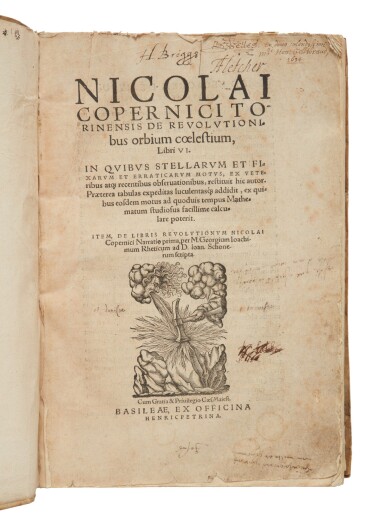
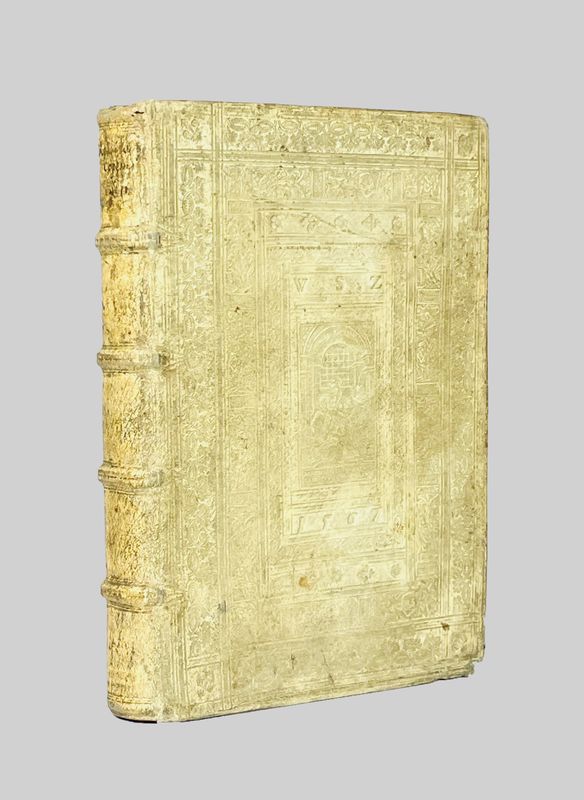
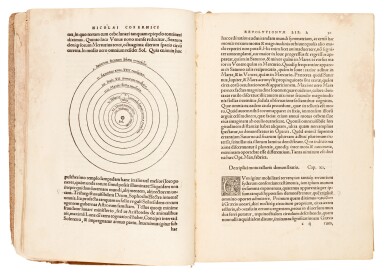


.jpg)

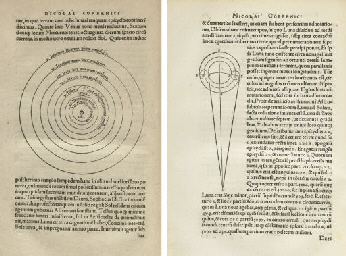
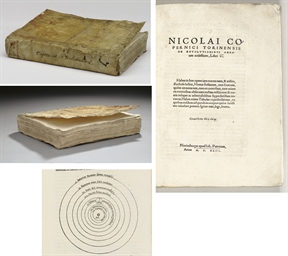
.jpg)
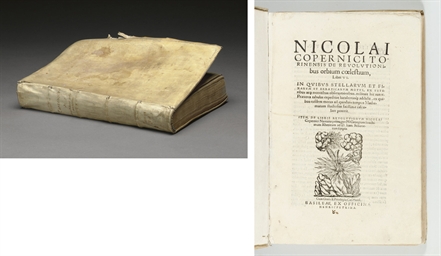
Testen Sie LotSearch und seine Premium-Features 7 Tage - ohne Kosten!
Lassen Sie sich automatisch über neue Objekte in kommenden Auktionen benachrichtigen.
Suchauftrag anlegen